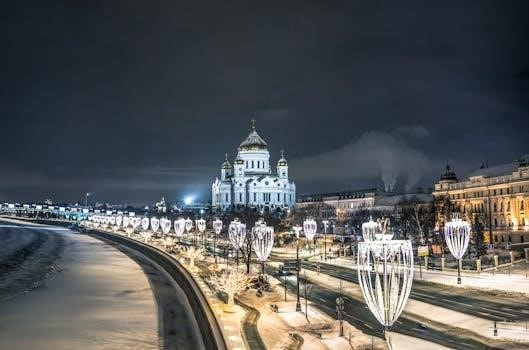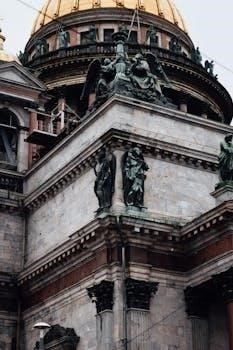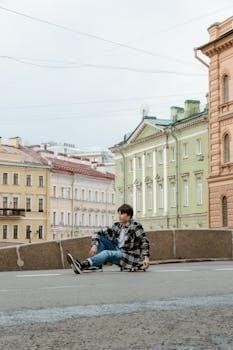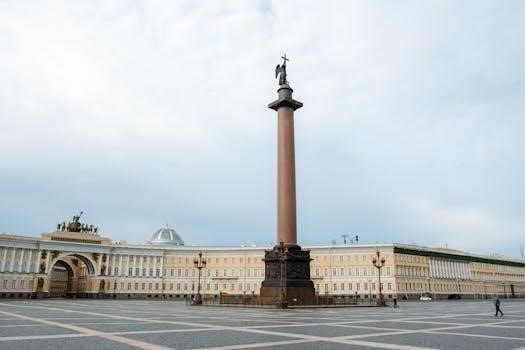Vladimir Ivanov’s “Russian Icons” is a seminal work exploring the rich heritage of Russian icon painting. This book delves into the history, artistic styles, and spiritual significance of these sacred images. It offers insights into their development and cultural impact.
Overview of the Book
This comprehensive book, “Russian Icons,” by Vladimir Ivanov, meticulously traces the evolution of Russian icon painting. It examines the Byzantine influences and regional variations, providing a detailed look at the artistic and spiritual development. The book also explores the role of icons within the Russian Orthodox faith and their reflection of religious life. It includes many color illustrations, enriching the reader’s understanding of this art form.
The Development of Russian Icon Painting
Russian icon painting evolved from early Byzantine influences, developing unique regional styles. This artistic journey reflects the interplay of religious beliefs and local traditions over centuries.
Byzantine Influences
Early Russian icon painting was heavily influenced by Byzantine art. This is evident in the use of specific artistic techniques, compositional elements, and the depiction of religious figures. These foundations from Byzantium provided the template for the initial development of Russian iconography, which later grew into distinct regional styles. The influence is seen in the solemn, spiritual character and symbolic imagery.
Regional Variations
As Russian icon painting developed, distinct regional styles emerged. Major cities like Moscow, Pskov, and Novgorod each fostered unique artistic approaches. These variations are noticeable in color palettes, the treatment of figures, and the overall aesthetic. These regional differences reflected the diverse cultural and spiritual landscapes across Russia. The styles add richness to the art of Russian icons.

Key Themes and Concepts
Central to the study of Russian icons are their profound religious significance and the ways in which they reflect Russian spiritual life; These themes offer a window into the culture.
The Role of Icons in the Russian Orthodox Faith
Icons hold an essential position within the Russian Orthodox faith, serving as windows to the divine and facilitating prayer. They are not merely artistic representations but are considered sacred objects that aid in spiritual connection, embodying a celebration of 1000 years of Christianity in Russia. Their historical narrative is intertwined with the church’s role.
Icons as a Reflection of Russian Religious Life
Russian icons serve as a profound reflection of the nation’s religious life, capturing both the spiritual devotion and the historical context of the times. They mirror the deeply held beliefs and values of Russian society, offering a visual narrative of faith and its evolution over centuries. They are more than art; they are a mirror.

Specific Iconographic Elements
Russian icons are characterized by specific elements, including depictions of saints, biblical scenes, and symbolic colors. These elements contribute to the icon’s spiritual and artistic significance, conveying deep meaning.
Saints and Scenes Depicted
Icons frequently feature revered saints like Sergius of Radonezh, along with scenes from the life of Christ and the Virgin Mary. These depictions often follow established iconographic traditions, serving to educate and inspire the faithful. The selection of specific saints and scenes reflects the theological and spiritual concerns of the period and region in which the icon was created. These representations connect viewers to the narrative of salvation.
The Use of Color and Symbolism
Color plays a vital symbolic role in Russian icons. Gold represents divine light and heavenly glory, while red signifies sacrifice and royalty. Blue symbolizes the heavens and the Virgin Mary’s purity. The use of specific colors and their combinations enhances the icon’s theological message. The symbolism extends to the gestures, clothing, and other details to convey spiritual meaning and narratives.
Artistic Styles and Techniques
Russian icon painting primarily employs the tempera technique on wooden panels. This method involves using pigments mixed with egg yolk, resulting in vibrant and durable artworks. Notable artists contributed to the evolution of iconic styles.
Tempera on Wood
The traditional technique of tempera on wood is central to Russian icon painting, offering a unique blend of durability and luminosity. This method involves using pigments mixed with egg yolk, applied in thin layers to prepared wooden panels. The resulting finish possesses a matte quality, allowing for rich, vibrant colors and a distinctive aesthetic that has characterized Russian iconography for centuries. This meticulous process contributes to the longevity and beauty of these sacred works.
Notable Artists Like Simon Ushakov and Theophanes the Greek
The history of Russian icon painting is marked by the contributions of masterful artists such as Simon Ushakov and Theophanes the Greek. Ushakov, known for his refined style, introduced elements of realism, while Theophanes, a Byzantine master, brought a dramatic and expressive quality. These artists significantly influenced the evolution of iconographic traditions, leaving an indelible mark on the art form with their unique approaches and styles that continue to be admired and studied.
Historical Context
Russian icon painting evolved within the context of the Russian Orthodox Church and its relationship with the political landscape. This interplay significantly shaped the development and styles of icons over centuries.
The Church and the Political Milieu
The Russian Orthodox Church held immense influence over icon production, with its doctrines and traditions directly shaping the subject matter and artistic conventions. Political events, such as the rise of Moscow and the establishment of the Tsardom, also impacted iconographic styles. These icons served as powerful symbols of both religious devotion and national identity, reflecting the intertwined nature of church and state in Russian history.
The 17th Century Aesthetic
The 17th century witnessed a shift in Russian icon painting, characterized by a move towards greater naturalism and detail. Artists like Simon Ushakov introduced more Western-influenced styles, incorporating realistic elements and perspective. This period saw a blending of traditional Byzantine techniques with new artistic approaches, resulting in a unique and distinct aesthetic. The influence of the Stroganov school was also prominent.
The Significance of the Book
Ivanov’s work provides a profound understanding of Russian religious life through the lens of icon painting. It serves as a valuable resource for those interested in art, history, and spirituality.
Opening a Window on Russian Religious Life
Through detailed analysis of Russian icons, Vladimir Ivanov’s book unveils the deep spiritual and cultural landscape of Russia. It allows readers to explore the central role icons play in the Russian Orthodox faith. The book illuminates how these images reflect the country’s religious practices, beliefs, and traditions, providing a unique perspective on its history and the lives of its people. It is a unique view into the soul of Russia.
Contribution to the Study of Russian Iconography
Ivanov’s “Russian Icons” significantly advances the field of Russian iconography. It offers a comprehensive examination of the subject, tracing the evolution of the art form from its Byzantine influences through its various regional expressions. The book provides valuable insights into the techniques, styles, and symbolism employed by Russian icon painters. It’s an indispensable resource for scholars and enthusiasts alike, solidifying its place in the study of Russian art.
Editions and Availability
The book “Russian Icons” by Vladimir Ivanov has seen multiple editions, including the first in English in 1987 and 1988. It is available in both hardcover and PDF formats.
First Edition Details (1987 and 1988)
The initial English edition of “Russian Icons” by Vladimir Ivanov was published by Rizzoli in 1988, following its original Italian release as “Il Grande Libro della Icone Russe” in 1987. This first English edition, a hardcover, features 219 pages with many color illustrations, some fold-out, offering a comprehensive look into Russian iconography. The book was a large-scale publication.
PDF and Hardcover Formats
Vladimir Ivanov’s “Russian Icons” is available in both hardcover and PDF formats, catering to different reader preferences. The hardcover edition, typically around 219 pages, showcases high-quality color reproductions. The PDF versions offer digital access, with some editions being 74 or 83 pages, possibly representing excerpts or scanned versions of the full text, which makes it more convenient for some readers.

Where to Find the Book
You can find Vladimir Ivanov’s “Russian Icons” at online retailers like Amazon and AbeBooks. It may also be available at some bookstores, libraries, and cataloging sites.
Online Retailers and Bookstores
Several online retailers, such as Amazon and Abebooks, list Vladimir Ivanov’s “Russian Icons” for sale. These platforms offer both new and used copies, often with varying prices. Additionally, some specialized bookstores, particularly those focusing on art history or religious studies, may carry the book. Check their websites for availability and ordering options. Keep an eye out for sales and promotions to get the best deal.
Libraries and Cataloging Sites
Libraries often hold copies of “Russian Icons” by Vladimir Ivanov. Check your local library’s catalog or use online library databases like WorldCat to locate a copy. Cataloging sites, such as LibraryThing, can also help identify institutions that have the book and may provide user reviews and additional information. These resources provide access to the book without the need for purchase.

Conclusion
Ivanov’s “Russian Icons” remains a vital resource, offering a lasting impact on the understanding of Russian religious art and history. Its detailed analysis continues to inspire scholars and enthusiasts.
Lasting Impact of Ivanov’s Work
Vladimir Ivanov’s “Russian Icons” has had a profound and lasting impact on the study of Russian iconography. His detailed exploration of the subject has made the rich world of Russian icon painting accessible to a wider audience. The book serves as a cornerstone for understanding the historical, artistic, and religious significance of these sacred images. It remains a vital resource for scholars and enthusiasts alike.
